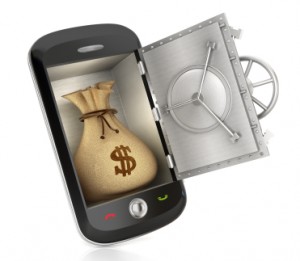Remember when mobile banking meant visiting your local branch? Today it means being able to make balance inquiries, deposits, and account transfers with just a few taps on your smartphone. And that’s just the beginning.
“The scope of mobile banking has clearly expanded over the last eighteen months,” said Sonia Lalli, a mobile banking analyst at Juniper Research, “particularly because of the expanded and more intelligent capabilities offered by the smartphone, as well as a greater range of affordable non-iPhone devices.”
However, transferring such sensitive data over the airwaves involves risk, and you should heed the dangers before you dive in. Here’s what you need to know about mobile banking [1] and how to protect yourself.
 What is Mobile Banking?
What is Mobile Banking?
Simply put, mobile banking is doing everything you’d do at a bank (or on your home PC) from your smartphone or tablet. That includes deposits, withdrawals, account transfers, and balance inquiries. These actions are done via SMS texts [2], a Web browser, or a smartphone-based app.
Since not all institutions have all three distribution methods, the ones that banks choose to support depend largely on the markets in which those money managers operate. For instance, financial institutions in developing markets generally will begin with SMS, a technology likely to be enabled even on lower-end feature phones.
Banking Apps
Another technology has seen a lot of growth, Lalli notes. “Using apps is an increasingly more important way of doing mobile banking, with the included functionalities being increasingly enhanced,” she said.
There’s pressure on financial institutions to offer apps on a variety of smartphone platforms and tablets in order to reach a larger number of people. Bank of America, Capital One, Chase, Citibank, and Wells Fargo all feature rich mobile banking apps, and they’re just a few in a growing field of choices.
Most of the services these institutions offer are similar across the board: Users can quickly check their balances, view account activity, pay bills, make transfers, and locate nearby ATMs and banking center location. But some banks are pushing the envelope. For instance, the Chase Mobile app lets users scan and deposit checks using their smartphone’s camera. They can also transfer money between two Chase accounts for instant payouts.
The Common Threats
- Stolen Smartphones – The biggest security threat to smartphones is having them stolen or lost and then not having any protection to hide or destroy the data stored in it. Someone who steals a device gains access to unprotected data such as ATM personal identification numbers, mobile banking security codes, passwords, and more.
- Phishing – This practice lets attackers acquire sensitive information such as passwords, bank details, and other sensitive information by disguising fake applications, emails, and SMS as genuine. Mobile phishing attacks are the most prevalent, as it is easy to implement and monetize the attack.
Here’s how a phishing scam might work: Unsuspectingly, you come across a website asking you to fill out typical details you might see on a form — username, password, your credit card details. Since the site looks and acts legitimate, you don’t question it. But it’s actually fake — and your information is being stolen by a third party at that moment.
- Malware – Smartphone malware may be unknowingly installed onto your device to leak sensitive information. Some particularly nasty software can even provide the attacker with full remote access to your device. Malware attacks are generally auto-run applications that leak sensitive user information such as banking information. Spyware programs, on the other hand, can enable attackers to gather specific information including user names, passwords, credit card details, and account details. A spyware program could also secretly monitor the user’s usage behavior.
How to Stay Safe
To begin with, install some type of mobile security application on your device. Juniper’s latest research shows that not even one in twenty smartphones and tablets has third-party security software installed, despite a steady increase in threats from online scammers, malware, and viruses.
Users should avoid unsecured and unauthenticated Wi-Fi or private networks and always double-check that they are not downloading an infected app or software. Even if an app seems to run properly on your device, there’s no telling whether a scammer has modified the source code before uploading the app to a public platform.
One surefire way to make sure it’s not infected is to download apps and APKs only from trusted sources — that is, no file-sharing websites. Scrutinize permissions carefully before installing apps onto your device. Although Apple and Windows Phone are pretty strict when it comes to letting apps tap into system resources, Android users should be wary of functions that suspiciously go beyond the scope of what an app claims to do.
©2012 Off the Grid News